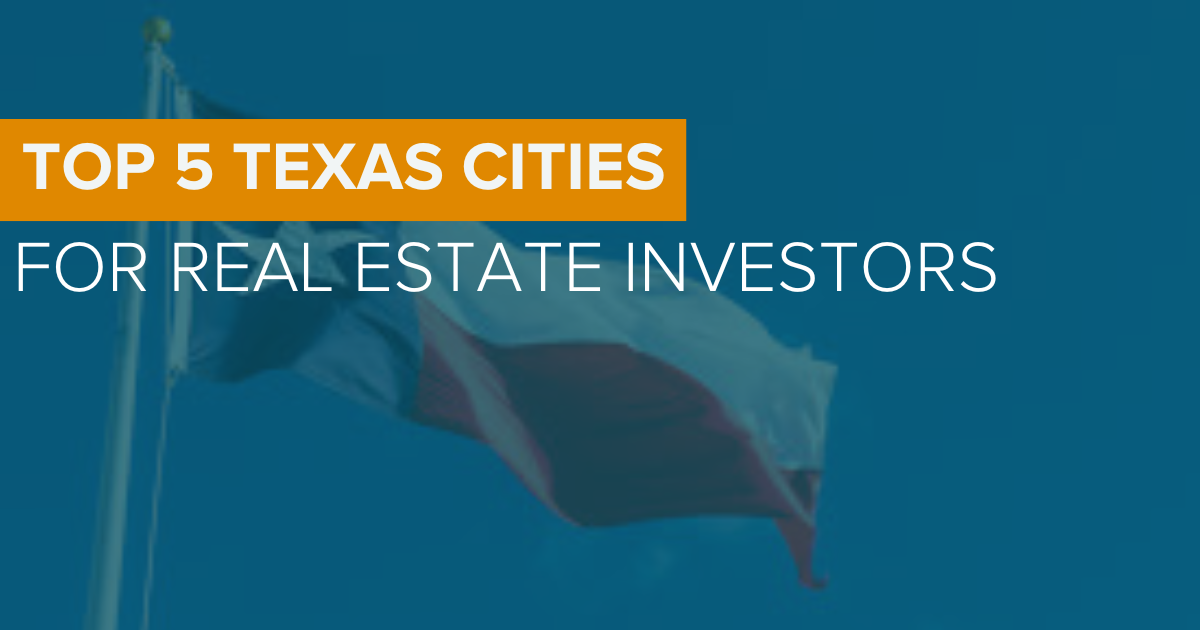Texas has cemented its status as a prime destination for real estate investors, driven by soaring real estate prices fueled by rapid population growth and a thriving job market.
According to recent estimates from the U.S. Census Bureau, Texas experienced the highest population growth in the country between 2022 and 2023.
Of the 1.6 million people added to the nation’s population during this period, nearly 30% settled in Texas. This influx, amounting to nearly 480,000 new residents, significantly boosted the Texas real estate market.
Major metropolitan areas such as Dallas, Houston, San Antonio, and Austin are among the top 10 in the nation for population increases from 2022 to 2023.
These cities have become hotspots for real estate investors, capitalizing on the growing demand for housing driven by Texas’ expanding population.
The Lone Star State is attracting new residents primarily due to the job opportunities available in some of the nation’s most rapidly growing industries.
In 2023, Texas led the nation for the second year in a row with the highest number of Fortune 500 headquarters, reaching a total of 55. The state represents over 10% of the Forbes Fortune 500 list, with 14 companies in the Top 100.
The greater Houston area ranks No. 2 nationwide with 25 Fortune 500 headquarters, and the Dallas-Fort Worth-Arlington area ranks No. 3 with 24.
The fastest-growing job sectors in Texas are concentrated in tech, resulting in numerous high-paying positions that drive up real estate prices.
Additionally, eight Texas cities are among the top 20 fastest-growing cities in the country, strengthening local real estate markets that are highly attractive to investors.
With ongoing population and job growth, Texas remains an excellent state for real estate investments well into the future.
We gathered data from reliable sources such as Redfin, Zillow, public state records, and others to create the most comprehensive list of the best places to buy investment real estate in Texas.
Houston
Houston experienced significant residential growth, driven by a diverse job market that ranks among the top in the nation.
According to the U.S. Bureau of Labor Statistics, total employment for the Houston metropolitan area increased by 80,700 jobs over the past year, with a local job growth rate of 2.4% surpassing the national average of 1.8%.
In particular, the education and health services sector saw a notable gain of 23,800 jobs, with health care and social assistance contributing 20,100 of those positions.
This sector’s 5.4% growth outpaced the national increase of 4.3%, reflecting Houston’s robust employment landscape.
Despite an unemployment rate slightly higher than the national average, the city’s stable employment with above-average income continues to fuel the growth of its real estate market.
Houston’s 2024 population is estimated at 6,802,326, reflecting an annual growth of 1.42%, with an increase of 95,332 residents in the past year. This makes it one of the most densely populated metropolitan areas in the country.
The absence of state income tax is also a major attraction for new residents, enhancing their purchasing power and benefiting residential buyers and investors alike.
As of April 2024, Houston, TX boasts an average home value of $271,943, up 2.3% over the past year, with homes typically pending in 20 days and 15.8% of sales closing above the list price.
However, securing financing for new multifamily construction has become challenging due to reduced real estate lending by banks and institutional investors pausing investments.
Consequently, new multifamily construction starts have dropped significantly across Texas from 2022, with Houston experiencing a 79% decrease. With the number of new units decreasing and the continued influx of people moving to Texas, a future imbalance in supply and demand is likely. For investors, this signals significant opportunities.
After the completion and leasing of current multifamily projects, there will be limited new properties to meet the demand from the growing population.
This supply-demand disparity is anticipated to manifest in 2025, making the construction plans initiated today crucial for addressing future demand. These upcoming projects are prepared to command higher rents, being among the few new properties available in their respective markets.
Austin
Austin continues to capture attention on both national and global scales. According to U.S. News & World Report, Austin is named one of the Best Places to Live in the nation for the 2024-2025 period, securing the No. 9 spot in the overall rankings.
Census estimates further emphasize Austin’s charm, showing that the Austin Metropolitan Statistical Area experienced substantial growth, adding over 50,000 residents between 2022 and 2023 at a rate of 2.1%.
With Austin ranked as the 26th most populous metro area in the country as of 2024 and boasting the seventh-largest increase in population from 2022 to 2023, Austin emerges as an enticing destination for real estate investors seeking promising opportunities in the capital of Texas.
In April 2024, the median home price in Austin increased by 0.9% year-over-year, reaching $570,000. Homes in the city typically sell in about 45 days, slightly faster than the 47-day average from the previous year. The number of homes sold in April rose to 904, compared to 813 in the same month last year.
Despite the slight decrease in the average time homes spend on the market, the 45-day period still indicates a relatively lengthy selling process. Higher interest rates, stricter lending criteria, or potential buyers being more cautious about making large financial commitments could slow down the buying process. Additionally, economic uncertainties or shifts in the local job market might make potential buyers more hesitant.
For real estate investors, the longer selling times suggest a more challenging market environment. Investors need to be prepared for extended holding periods, which can increase carrying costs and affect cash flow.
However, the increase in median prices and the number of homes sold also indicate a robust demand, which means that, despite the longer selling times, there is still significant interest in Austin’s real estate market.
Investors may need to focus on properties that offer good value or have unique selling points to attract buyers more quickly. Using hard money loans can greatly benefit investors in Austin.
These loans are faster and easier to obtain than traditional bank loans, which is crucial in a competitive market. Since hard money loans are based on the property’s value rather than the borrower’s credit, they are accessible to more investors.
These loans also provide capital for fix and flips, helping increase property value and attract buyers quickly. Although they come with higher interest rates, the speed and flexibility allow investors to seize opportunities and enhance profitability in Austin’s dynamic real estate market.
The average rent for an apartment in Austin is $1,707 as of April 2024, with the typical apartment size being 863 square feet. However, this varies widely with numerous options available, from economical studios to luxury apartments and houses.
Studio apartments are the smallest and most affordable, while one-bedroom units are closer to the average. Larger two-bedroom and three-bedroom apartments offer more space.
In Austin, 55% of households are renter-occupied, presenting a prime opportunity for real estate investors due to the steady demand for rental properties. Rental vacancy rates are 6.2%, which is low for such a populated city and a huge advantage for BRRRR investors looking for stability in their rental portfolio.
For those seeking the most affordable neighborhoods, Coronado Hills, Highland, and St. Johns each offer average rents of $1,411 per month.
Other cost-effective areas include Georgian Acres, Harris Ridge, and Heritage Hills, where the average rent is $1,417 per month as of April 2024.
Dallas
As a major travel hub with another hot job market, Dallas is an attractive spot for real estate investors. The Dallas region maintains its position as the nation’s leader in total new residents, with 152,600 people added to its population from 2022 to 2023, according to the latest U.S. Census Bureau data. The current metro area population of Dallas in 2024 stands at 6,655,000, reflecting a 1.23% increase from 2023. This influx of residents contributes to the city’s thriving real estate market, making Dallas an enticing prospect for real estate investors seeking opportunities in a dynamic and growing market.
In Dallas, the average home value stands at $320,471 as of 2024, signaling a 2.8% increase over the past year, with homes typically pending in around 17 days.
Notably, 20.4% of sales close above the list price, indicating a competitive market. In 2023, builders constructed approximately 50,000 new homes in Dallas, while 17,000 homes were purchased and then resold as flips. This suggests that about one-third of the new inventory is comprised of homes that have been remodeled and reintroduced to the market.
Fix-and-flip investors play a crucial role in addressing the housing inventory issue by bringing renovated homes back to the market. This strategy helps alleviate the shortage of available homes and provides buyers with more options.
Homes in Dallas are increasingly in demand, with popular amenities such as home offices, outdoor pools, and central air conditioning driving higher listing attention and initial bids.
Utilizing new construction loans to build homes to match market demand is a creative way that developers can use outside capital to ensure they receive the highest possible selling price, using a portion of the profit to pay off their hard money loan.
Currently, the average rent for an apartment in Dallas is $1,559, which is a 2.4% year over year decrease. With 59% of Dallas households being renter occupied, there is a substantial market for real estate investors looking to profit from renovating and renting a property in Dallas.
Additionally, the rental vacancy rate is 8.1%, slightly higher than average, due to the combination of new construction, downsizing, and tenants deciding to sublease their existing space.
For those seeking affordable neighborhoods, Arbor Ridge, Arbor Springs, and Casa Loma Estates offer average rents of $935 per month. Other cost-effective areas include Garden Heights, Hickory Creek, and Highland Vista Estates, with rents also at $935 per month.
Real estate investors employing the BRRRR strategy should consider Dallas for its consistent growth and large renter population, especially in neighborhoods like Grammercy Place, Idlewild, and Victory Park, which are known for their safety and proximity to popular attractions.
San Antonio
San Antonio is an attractive market for real estate investors, offering affordable housing options compared to other major Texas cities. The median home price is $260,871, which is more favorable for buyers. The metro area population has grown to 2,491,000 in 2024, marking a 1.51% increase from the previous year.
Despite a slight decrease in home values over the past year, with a 1.8% decline, the market remains dynamic as of June 2024, with homes going to pending status in around 31 days.
San Antonio’s rental market is strong, with a vacancy rate of less than 8%, ensuring a reliable income stream from rental properties.
For fix and flip investors, San Antonio’s market is particularly enticing. Homes are selling quickly, and desirable properties receive multiple bids and sell for above the asking price – 16.4% of home sales in April 2024 were over the list price.
Investors can utilize hard money loans to acquire properties, complete necessary renovations, and quickly sell for a profit, using the proceeds to repay the loan and move on to the next project. This strategy is supported by the city’s demand and relatively low entry price points.
As of June 2024, the average rent in San Antonio, TX is $1,094 per month, which is 28% lower than the national average of $1,517 per month, making it more affordable than most cities in the US.
Rent for a studio apartment averages $907 per month, a one-bedroom costs around $1,094, a two-bedroom averages $1,384, and a three-bedroom rental is approximately $1,794 or more. Over the past year, rent has decreased by 1.6% between 2023-2024, amounting to an average of $18 less per month.
This decrease can be attributed to an oversupply of new apartment buildings, now at a 50-year high, leading to a rapid drop in rental prices. Despite this, there are optimistic aspects for rental property owners. Lower rents can attract more tenants, reducing vacancy rates and ensuring steady income.
Additionally, San Antonio’s strong economic and population growth trends suggest long-term increases in rental demand and property values. This market adjustment could lead to more stable rental prices and sustainable growth, offering a competitive advantage to well-managed properties and attracting new investment opportunities.
For those looking to invest in rental properties, San Antonio’s affordability and stable rental market make it an attractive option. The best neighborhoods for investment properties, considering rental prices, safety, and proximity to popular venues and shops, are Government Hill, Cedar Creek, and Forest Crest.
Corpus Christi
Corpus Christi’s coastal allure and natural beauty make it an ideal destination for vacation rentals, offering investors a profitable opportunity. With its picturesque beaches and a plethora of outdoor activities, including boating, fishing, and birdwatching, the demand for short-term rentals remains high throughout the year. This diversity in the market provides opportunities for investors to capitalize on both the stability of long-term rentals and the profitability of vacation rentals.
The city also has a strong connection to the Navy and other armed services, with the city’s naval station being the largest employer in the entire state. This is important for investors to understand because military personnel receive stipends and benefits in regard to housing, allowing them to purchase or rent property more easily than other middle-class focused cities. Markets around military bases also tend to have more turnover, with people constantly coming and going. While this could be a detriment due to the need to frequently replace tenants, it also provides an advantage by offering opportunities to renovate properties and increase rents.
Corpus Christi’s housing market shows resilience with an average home value of $224,231, a modest increase of 1.2% over the past year, with homes typically pending in about 31 days. Approximately 9.2% of sales go above the list price.
Renting in Corpus Christi offers options, with the average apartment rent at $1,146 per month, varying based on factors like location and size. The median rent in Corpus Christi fell by 0.3% over the course of May 2024, and has now decreased by a total of 3.5% over the past 12 months.
Corpus Christi’s rent growth over the past year is similar to the state average of 2.9% but has fallen below the national average of 0.8%. As of June 2024, rental occupancy is split, with 43% of households being renter-occupied and 57% owner-occupied.
With 43% of households in Corpus Christi being renter-occupied, real estate investors have a stable market with a consistent stream of potential tenants. This presents a lucrative opportunity for generating steady rental income and diversifying investment portfolios.
For those seeking affordability, neighborhoods like Chapman Ranch, Central City Corpus Christi, and Flour Bluff offer average rents of $949, $980, and $1,036 per month, respectively. Additional options include Mustang Island, N.A.S., and North Padre Island, all below the city’s average rent of $1,146 per month.
In Review
The surging population growth and thriving job sectors statewide have made local real estate markets fiercely competitive yet rewarding for investors. Whether you’re a fix-and-flip investor leveraging quick turnaround times for multiple deals or a developer capitalizing on new construction opportunities for maximum home sale prices, Texas offers diverse investment options to suit various budgets.
For BRRRR investors aiming to initiate or expand their rental portfolios, Texas presents an attractive landscape. Cities like Austin and Dallas provide stable rental properties capable of generating positive cash flow for investors in the rental market.
Asset Based Lending is financing Texas real estate investors using flexible loan programs that includes fix and flips, new construction, and long-term rental property loans. If you’re looking to scale your real estate business by using hard money loans, then ABL is ready to help. Contact us today to be approved for the most reliable hard money loans Texas has to offer.







0 Comments